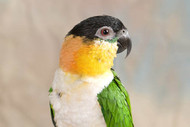Black-Headed Caique Fact Sheet
Posted by Black-Headed Caique Facts, owning a Black-Headed Caique, what to feed a Black-Headed Caique on 20/9/2013
Find out more about the Black-headed Caique. Rosemary Low takes a look at these distinctive little white-breasted Parrots which she feels have a lot going for them as companion birds: they are small, yet highly active and easily intrigued. Read on to learn more about the pros and cons of caring for Black-headed Caiques.
Scientific name
Pionites melanocephala
Alternative name
Black-capped Parrot (ornithological literature).
Adult length
23cm (9in)
Adult wingspan
36cm (14in)
Find everything you need for a Black-headed Caique right here.
Adult weight
about 160g
Potential lifespan
about 28 years
Status in wild
Fairly common in lowland forest.
Origin
North of the Amazon. The nominate race occurs in Brazil, the Guianas, Venezuela and Colombia. Nearly all the Black-headed Caiques imported into the UK originated from Guyana and Suriname.

Sub-species
The sub-species pallida is reportedly found from southern Colombia to north-eastern Peru and eastern Ecuador. It is apparently recognised by the paler shade of yellow and the paler orange-yellow band on the neck. However, scientists? delineation of the range of the two sub-species may be incorrect. Examination of museum skins from Venezuela shows wide variation in the orange or yellow coloration so it may be that the sub-species pallida is invalid.
Note that there is one other member of the genus, found only south of the Amazon, the White-bellied Caique (Pionites leucogaster), which differs mainly in having the crown and forehead orange, not black.
Suitability
These distinctive little white-breasted Parrots have one big advantage as companion birds: they are small.
Unlike nearly all other Parrots, if they must be wing-clipped, they don?t seem to suffer as they are still very active and playful, and hop around, exploring every nook and cranny.

The appeal of young birds is irresistible, heightened by their more upright stance than most Parrots and confident, swaggering walk. Extremely active, playful and amusing, they are often referred to as the clowns of the Parrot family.
Disadvantages
Purchasers should beware if they are seeking a companion bird; Caiques can get nippy! They should also know that the voice is shrill and high-pitched and could become irritating. A word of warning here!
Caiques love to get into small spaces. In the wild they roost in holes in trees unlike some of the larger and more numerous Parrots that roost on tree branches or in clumps of bamboo. This means they will explore any hole they can squeeze into. Make sure it is not a hole behind the fire or a gap in furniture. Block up any such holes before you bring your bird home.
Immature Plumage
Colouration tends to be variable. Most young birds have the white breast suffused with yellow, and in some there is also an orange suffusion.The rest of the plumage is slightly paler throughout and the wings are usually tinged with blue.
The bill is grey, soon changing to black and the naked skin surrounding the eye and on the cere is pinkish-grey, unlike the dark grey of adults. A good indication of a young bird is the brown eye colour (reddish-brown in adults).

Training
Caiques are very strong-willed little birds and like other Parrots, they need firm and kind discipline if they are to make good companions in the home. This means teaching them to step on to the hand when required, so that they can be returned to the cage. Because they are so fearless, and have no idea how small they are, they do not hesitate to approach cats and dogs and could get into trouble unless they can quickly be removed out of the path of danger.
Bathing
Frequent bathing is enjoyed and is very important to keep their plumage in good condition. Do not keep these birds near a radiator as the atmosphere will be too dry.
One or more?
Caiques are highly sociable in their family groups and like to have another bird as a companion, but great care must be taken when introducing two birds. They have instantaneous and sometimes aggressive reactions and if a new bird is introduced without a period of introduction, it could be killed. It is therefore important to house them in adjoining cages or aviaries first of all.
A single Black-headed Caique that does not have a close relationship with a human can seem quite desperate for an avian companion. If the owner is reluctant to acquire another Caique because breeding is not desirable, another small South American Parrot such as a Conure often makes an excellent companion.
Need to Gnaw
Caiques are great gnawers so perches will need to be replaced regularly. Branches from apple trees make the best perches or branches from the wood of another fruit tree. Willow should be provided every week for gnawing, entertainment and the beneficial properties of bark. If they cannot whittle away, their beaks will become overgrown. There should be no need to trim the nails except, perhaps, in a really old bird.
Diet
In addition to the usual seed and/or pellets, Caiques eat a lot of fruit. They enjoy apples (including the pips, which are not harmful), sweet oranges, sweet grapes (preferably black), pears and, in season, cherries and pomegranates.
Tropical fruits such as guavas, mangos and passion fruits add variety. They love seasonal soft fruits such as raspberries, redcurrants, blackberries and cranberries. Note the hazards involved in feeding elderberries and blackberries unless you want your walls dyed black! Hawthorn berries are relished.
Get lots of great tasting Black-headed Caique food here.

Click here for lots of Caique products.

